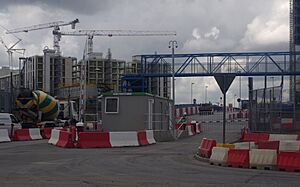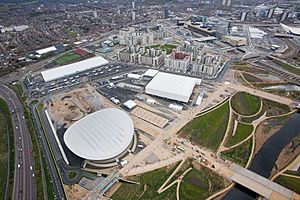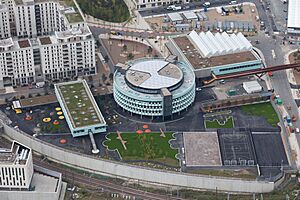East Village, London facts for kids
Quick facts for kids East Village |
|
|---|---|
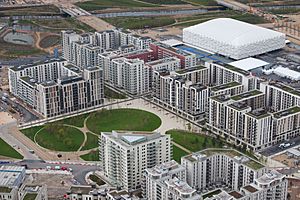 Olympic and Paralympic Village, April 2012. To the rear is the temporary Basketball Arena |
|
| OS grid reference | TQ385845 |
| • Charing Cross | 6 mi (9.7 km) WSW |
| London borough | |
| Ceremonial county | Greater London |
| Region | |
| Country | England |
| Sovereign state | United Kingdom |
| Post town | LONDON |
| Postcode district | E20 |
| Dialling code | 020 |
| Police | Metropolitan |
| Fire | London |
| Ambulance | London |
| EU Parliament | London |
| UK Parliament |
|
| London Assembly | |
East Village is a cool neighborhood in Stratford, East London. It was first built as the Olympic Village for the 2012 Summer Olympics. After the games, it became a new place for people to live. It now has homes, shops, cafes, and restaurants. This area used to be old industrial land. Today, over 7,000 people call East Village home.
The neighborhood is part of the larger Queen Elizabeth Olympic Park. A group called the London Legacy Development Corporation helps plan its future.
Contents
Building the Olympic Village
From Idea to Construction
When London was planning to host the 2012 Summer Olympics, they had a smart idea. They wanted to build a special village for the athletes. But they also wanted to use these buildings after the games. The plan was to turn them into a new neighborhood for people to live in.
A company called Lend Lease was chosen for this big project. They would build the Olympic Village. It needed to house 22,500 athletes and team members. This included 16,000 for the Olympics and 6,500 for the Paralympics. The buildings were designed to be easy for everyone to use, including people with disabilities. After the games, these homes would be for families. The plan also included offices, shops, schools, and a health center.
Designing the New Neighborhood
Architects and designers worked together on the village. They wanted it to feel like a "village-garden" area. It was designed to fit in with the green spaces of the Olympic Park. The layout was inspired by older London neighborhoods.
The area is about 27 hectares (that's like 67 football fields). It has 14 groups of buildings. Each group has 5 to 7 blocks built around shared squares and courtyards. There are also water features nearby, as the River Lea is close. Each of the 69 buildings is 8 to 12 stories tall.
On the ground floor, you'll find townhouses with front doors facing the street. There are also shops and offices. Above the ground floor, there are shared gardens. These gardens are built on top of hidden car parks. The apartments above offer different sizes, from small studios to five-bedroom homes. Each apartment has its own balcony, big enough for a table and chairs.
Challenges and Changes
Building such a large project had its challenges. There was a big financial crisis around 2008. This made it hard for Lend Lease to get all the money needed. So, the government stepped in to help. They also decided to make the project a bit smaller at first. Some athletes would stay closer to their events outside London.
To fit more athletes during the games, apartments were temporarily changed. For example, a one-bedroom apartment might become a four-bed space. This was done by adding temporary walls. After the games, everything was changed back to the original design.
Before construction, the site had old industrial buildings. It also had some contaminated land. There were also two living areas for Irish Travellers. These families had to move as part of the project.
East Village During the Olympics
A Home for Athletes
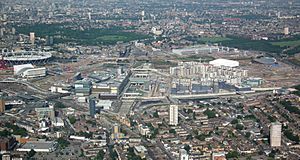
In the summer of 2012, the buildings were used as the Olympic Village. They had 3,300 apartments. Each apartment had a TV, internet, and a private courtyard. There were 17,320 beds in total for athletes and officials. Each athlete had about 16 square meters of space.
The village also had two large temporary buildings. One was a huge food hall, open 24 hours a day. It could feed 5,500 athletes at once! The other was an entertainment hall. It had video games and a place for athletes to relax. There was also a special plaza where athletes could meet their friends and family.
Many countries stayed in different buildings. For example, the British team stayed in Calla House. Greece stayed in Hopground House, and Spain in Carina House. Plaques in the buildings still show which countries stayed there.
East Village After the Games
A New Place to Live
After the Olympics, the housing was changed into the new East Village neighborhood. It now has 2,818 new homes. This includes 1,379 affordable homes for sale and rent. The area has wide open spaces with gardens and parks. It also has a school, a health clinic, and shops.
A company called Delancey and Qatari Diar bought the remaining homes. They paid £557 million for the site. The homes are rented out instead of being sold. This created a new way for private companies to manage many rental homes in the UK.
The temporary walls used during the games were removed. This created different sized homes, from apartments to townhouses. Kitchens were added to the rooms that were once like hotel rooms. New parks and better transport links were also created. A health center was built for everyone living in East Village and nearby. Many independent shops and businesses have moved into the area. In 2023, plans were approved to build even more rental homes and student housing.
Chobham Academy
A new school called Chobham Academy was also built. It has space for 1,800 students aged 3 to 19. During the Olympics, the school building was used by the teams. After the games, it was rebuilt and opened in September 2013. Chobham Academy includes a nursery, primary school, and secondary school. It also has adult learning facilities and a community arts center. In 2015, the school was rated 'Outstanding'.
Getting Around East Village
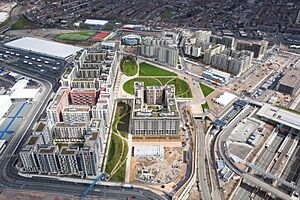
East Village is very well connected by public transport. It's right next to Stratford International station. From here, you can take fast trains to central London in just 5–6 minutes. The Docklands Light Railway (DLR) also connects East Village to many parts of East London.
Just one stop away is Stratford station. This is a major transport hub. You can catch trains on the Great Eastern Main Line, Elizabeth Line, and London Overground. It also has the London Underground Jubilee and Central lines.
Many London bus routes serve East Village directly. These include routes 97, 108, 308, and 339. There's also a night bus, N205. Other bus routes stop nearby.
East Village is about 10 kilometers (6 miles) from Big Ben. Since January 2016, both Stratford and Stratford International stations are in London's Zone 2/3 for public transport.
Green and Sustainable Living
East Village was designed to be very eco-friendly. The homes were built to meet high standards for sustainable living. This means they use less energy and water.
The car park for Stratford International Station also received an "Excellent" rating for its environmental design. All the wood used in construction was checked to make sure it came from responsibly managed forests. This is called FSC certification.
During construction, the project won three Gold awards. These awards are for being a "Considerate Constructor." This means they worked hard to be good neighbors and protect the environment during building.
Images for kids



